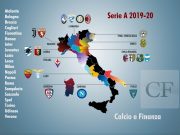Financial Fair Play has never been so frequently and so widely talked about in the world of football as it has been this summer.
On the whole, people have talked about it erroneously; Andrea Traverso (UEFA) recently explained that “Financial Fair Play carries out checks a posteriori, it doesn’t say what to do and what not to do. Everyone is free to do as they wish, but there are consequences.”
A lot of misleading observations are being made in the face of some incontrovertible facts.
The results are unequivocal: an increasing gap between the top European clubs and the rest of the continent, and the domination of continental football by a select few clubs in recent seasons.
Real Madrid’s victory in the Champions League, their 3rd European success in 4 years, matching the almost 30-year old record held by Sacchi’s Milan as the last back to back winners of the competition, ensured that the world’s most prestigious tournament has lost its facade of randomness, having lasted so long with the myth that no one could win it twice in a row.
How has European football reached this point?
The prevailing opinion not only among fans but also many self-proclaimed analysts is that Financial Fair Play is the main culprit.
But this short-sighted conviction can quickly be taken apart.
Football, as we know it today, is much more the result of the Bosman ruling than of FFP.
Other than introducing the free transfer, the ruling – which came in December 1995 – also had the effect that it effectively liberalised the football market throughout Europe.
Ever since then, we’ve seen diverging paths emerge.
The labour market is pan-European, while competitions have remained largely national. If a team plays in Europe they play either 13 games (to reach the Champions League final) or 15 games (Europa League final), compared to 38 league games plus cup competitions.
Unlike the old days, talent that teams buy in the transfer market has ended up being concentrated in a small number of clubs.
European football is experiencing the same paradox as European politics: it must prioritise its national interests, but it also has to take continental integration into account.
Putting the effects described by Zipf’s Law into basic terms, there is a certain amount of talent in the football market that, over time, tends to increase proportionally less than the financial resources that are available.
Ultimately, this is very similar to verticalisation, which characterises all free markets across the world.
This is why the Americans, who are masters of liberalism, have built their sports on the foundations of competition, putting their leagues – not the clubs – at the centre of their systems.
As a result, the European market, which was once much more varied and competitive (looking at the number of teams that reached the semi-finals of the Champions League), has seen market values verticalise in a very similar way to what happened in previous decades at a national level.
20 years on from the Bosman ruling, 3 of the continent’s 5 top leagues have a single dominant club (Italy, Germany, France), while Spain is home to a powerful duopoly; only England has seen a more competitive system emerge.
As well as the effects of the Bosman ruling, there is also a secondary phenomenon, which is obviously the substantial changes in clubs’ business models.
Italian football dominated the scene as long as clubs invested more money in the transfer market than foreign clubs.
Anything was possible in a loss-making system, as the growth of TV rights allowed spending to continue without the requirement to think about generating the required revenue streams.
But TV money wasn’t just an Italian phenomenon. Other countries also had more resources available, but there was a difference: while Italian clubs continued to rely on rich owners, big European clubs started to rely on revenue-based models.
And in this case, the clubs that excelled were the ones who were able to rely on European-wide branding and who made their mark before the others.
This was the case for Barcelona, Real Madrid, Bayern Munich, Manchester United, as well as the London clubs Chelsea and Arsenal, and even Liverpool and, later, PSG.
The time effect is clear in Juventus‘ case, who have been operating with a revenue-based model (initially based primarily on transfer revenue and player profits, before broadening their scope) since 1996/97, when the owners asked the club’s management to adopt a self-sufficient model; in the last 10 years, since Calciopoli in 2006, they have slipped from 3rd to 12th in the ranking of European clubs’ revenues.
In all cases, there are 2 crucial aspects: an internationally recognisable brand and a large potential fan base.
This is proven by emerging clubs (those who, before 2000, weren’t especially well-known on the international scene) like Chelsea and PSG, based in London and Paris. These two clubs have been able to catch up on other clubs (Abramovich’s Chelsea started in 2004, the Qatar-backed PSG in 2010) thanks to their rich owners being able to bankroll their respective clubs.
FFP arrived after all this. It was set up in 2009 and came into effect in 2011.
The principle detractors of Financial Fair Play are supporters who want to see their clubs be successful and who complain about the fact that they cannot spend certain amounts on certain players.
But in order to judge FFP, we have to think of a system without FFP.
If club X, who aren’t spending because they are trying to live within their means, were able to spend money freely, they would be no more competitive compared to club Y who generate an income that is 4 or 5 times larger.
Then consider the additional effects if club Y were also able to spend what they wanted.
And this doesn’t happen because some owners are more parsimonious than others, but because once you reach a certain volume of business, it becomes more and more difficult to compete and it becomes easier to achieve investment-revenue targets when you are at the top of the revenue pyramid.
The only effect this will have is on talent inflation. Because faced with increased resources to spend on unchanged pool of talent, prices would naturally increase from what they were previously.
This is, in some ways, what has happened in England, where the collective’s increased financial resources hasn’t improved the clubs’ competitiveness on an international level – on the contrary, they seem to have been negatively affected as their results in European competitions show – despite the fact they always pay 20-30% more for a player.
English clubs aren’t winning in Europe simply because they are the only ones who have to compete on two fronts (at home and abroad), while always paying a premium.
In the meantime, prices are increasing. The €220 million spent on Neymar in the face of UEFA’s spending controls caused uproar, but there was no uproar when Ronaldo’s release clause was triggered despite Inter’s business model being completely reliant on the owners’ annual injections of capital during the 1990s and 2000s.
To be clear, this isn’t a challenge to the system, but the causes and effects need to be analysed.
But fees are increasing proportionally less than they would without FFP. And UEFA’s Andrea Traverso can rightly argue that: “In 2010, football lost €1.7 billion, now we’re €300 million in the red. The system is growing and is financially sustainable.”
The fact that UEFA are now talking openly about intervening and making increased competition their next goal isn’t evidence that FFP has failed, but merely that even greater balance is required. That another step forward is needed.
In the meantime, the subject of the labour market remains on the table.
In an international system where there are no limits to operations and where the top clubs can move around dozens of players who will never play for the first team every summer, competitiveness will always be a chimera.
A salary cap is a good idea, though it presents its own limitations, highlighted by the economist Umberto Lago who explains (with the same European and national perspectives that we have used throughout): “A salary cap will be looked at. But some leagues cannot afford to pay the same wages as others, so there is the risk of giving the richer leagues greater advantages.”
But the impression is that squad number limits, limits (of age and duration) on loans and limitations on the number of players who can be registered are the first regulations that should be introduced in order to achieve greater balance.
As well as a fresh look at the regulations on corporate and stakeholder ownership.
In short, sporting regulations, this time, should be prioritised over financial ones.






































